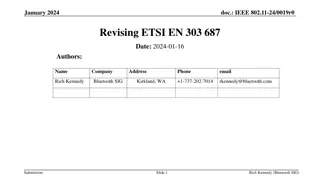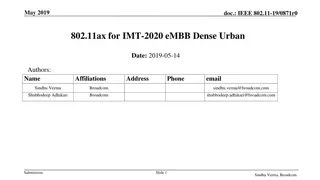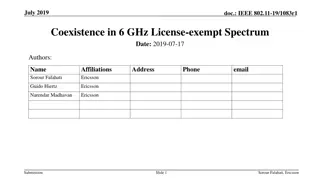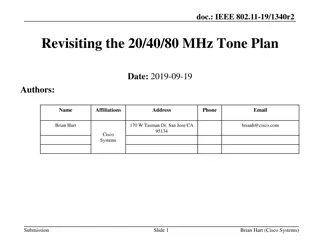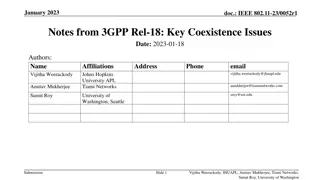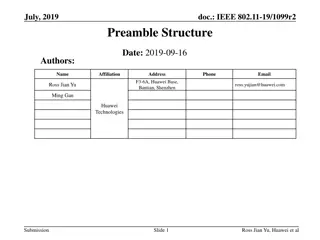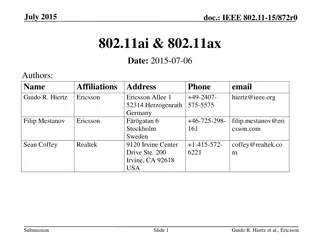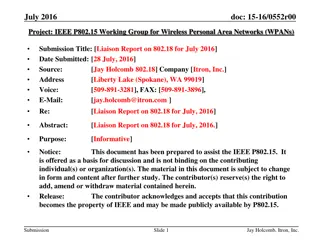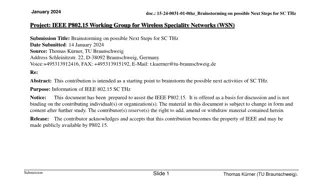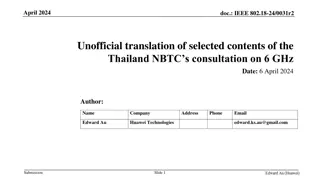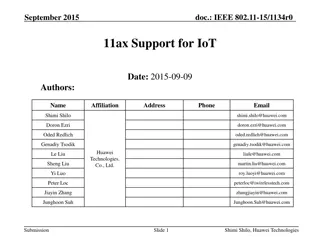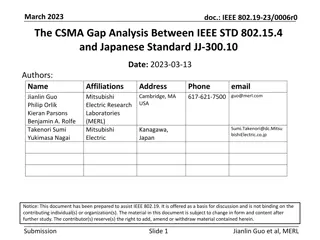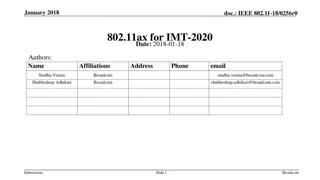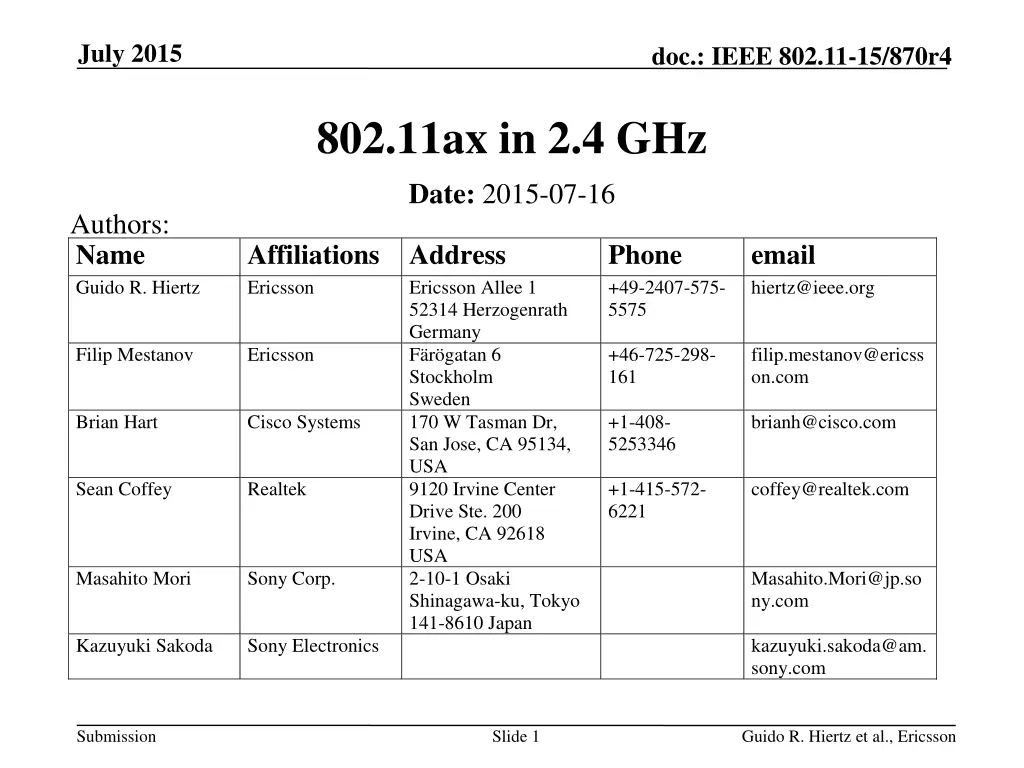
IEEE 802.11ax in 2.4 GHz: Addressing Spectrum Efficiency
Explore the significance of the 2.4 GHz spectrum in IEEE 802.11 devices, including the management of Basic Service Sets, channel assignments, probe request frame transmissions, and the introduction of High Efficiency STAs. Discover how IEEE 802.11ax strives to optimize spectrum utilization for enhanced performance.
Download Presentation

Please find below an Image/Link to download the presentation.
The content on the website is provided AS IS for your information and personal use only. It may not be sold, licensed, or shared on other websites without obtaining consent from the author. If you encounter any issues during the download, it is possible that the publisher has removed the file from their server.
You are allowed to download the files provided on this website for personal or commercial use, subject to the condition that they are used lawfully. All files are the property of their respective owners.
The content on the website is provided AS IS for your information and personal use only. It may not be sold, licensed, or shared on other websites without obtaining consent from the author.
E N D
Presentation Transcript
July 2015 doc.: IEEE 802.11-15/870r4 802.11ax in 2.4 GHz Date: 2015-07-16 Authors: Name Guido R. Hiertz Affiliations Address Ericsson Phone +49-2407-575- 5575 email hiertz@ieee.org Ericsson Allee 1 52314 Herzogenrath Germany F r gatan 6 Stockholm Sweden 170 W Tasman Dr, San Jose, CA 95134, USA 9120 Irvine Center Drive Ste. 200 Irvine, CA 92618 USA 2-10-1 Osaki Shinagawa-ku, Tokyo 141-8610 Japan Filip Mestanov Ericsson +46-725-298- 161 filip.mestanov@ericss on.com Brian Hart Cisco Systems +1-408- 5253346 brianh@cisco.com Sean Coffey Realtek +1-415-572- 6221 coffey@realtek.com Masahito Mori Sony Corp. Masahito.Mori@jp.so ny.com Kazuyuki Sakoda Sony Electronics kazuyuki.sakoda@am. sony.com Submission Slide 1 Guido R. Hiertz et al., Ericsson
July 2015 doc.: IEEE 802.11-15/870r4 Abstract Recently more 802.11 devices capable of operating in 2.4 GHz & 5 GHz than devices supporting 2.4 GHz only have been shipped. However, the majority of BSSs still operate in 2.4 GHz and 5 GHz usage lacks behind. Although 2.4 GHz band is often referred to as junk band, it plays a vital role for 802.11. Also because the 2.4 GHz spectrum has a lower free space path loss than 5 GHz, the 2.4 GHz spectrum should not be given up. 802.11ac addresses the 5 GHz only, but the industry s interest in backporting features to 2.4 GHz outlines the importance of the latter spectrum. 802.11ax will address both 802.11 bands and thus the 2.4 GHz band should not be ignored. It has been shown that 802.11 s Basic Service Set (BSS) management works robust but inefficient. A lot of airtime (up to 58% = 90% 64%, see [2]) is wasted with management frame traffic. We propose a simple addition to the 802.11ax Specification Framework Document (SFD) that has been highlighted by others before. Submission Slide 2 Guido R. Hiertz et al., Ericsson
July 2015 doc.: IEEE 802.11-15/870r4 2.4 GHz channel assignment 802.11 default channel bandwidth is 20 MHz 5 MHz channel number increments Few non-overlapping channels (1, 6, 11) Some regulatory domains have extra channels (13, 14) [3] reports about random channel assignment Many operators not aware of channel overlap Dissimilar channel numbers treated as indicator for dissimilar frequency channels Submission Slide 3 Guido R. Hiertz et al., Ericsson
July 2015 doc.: IEEE 802.11-15/870r4 Probe request frame transmissions Many devices send probe frames on every channel available in 2.4 GHz (1 11 resp. 13) With DSSS, probes can be easily received when off one or two channels See [1-3] Huge amount of probe response frames APs on- and off-channel respond Probing device receives the same responses multiple times when walking through all 2.4 GHz channels Submission Slide 4 Guido R. Hiertz et al., Ericsson
July 2015 doc.: IEEE 802.11-15/870r4 HE STAs and 2.4 GHz channels With OFDMA 802.11ax introduces a new paradigm Physical & virtual carrier sensing important to align with OBSS Avoid partially overlapping channels HE operation (even if mixed with legacy modes) should ban the use of non-orthogonal channels In the 2.4 GHz band, HE APs shall not operate on channels other than 1, 6, and 11 Non-AP HE STAs shall probe on channels 1, 6, and 11 before probing on any other channel in 2.4 GHz Submission Slide 5 Guido R. Hiertz et al., Ericsson
July 2015 doc.: IEEE 802.11-15/870r4 STRAW POLL Submission Slide 6 Guido R. Hiertz et al., Ericsson
July 2015 doc.: IEEE 802.11-15/870r4 Straw Poll Do you agree to add the following to the IEEE 802.11 TGax Specification Framework? Add to the end of Clause 6 (MAC): The amendment shall define that HE APs shall not operate a primary channel on channels other than 1, 6, and 11 in the 2.4 GHz band. Non-AP HE STAs shall probe on channels 1, 6, and 11 before probing on any other channel in 2.4 GHz. Yes: 77 No: 6 Abstain: 60 Submission Slide 7 Guido R. Hiertz et al., Ericsson
July 2015 doc.: IEEE 802.11-15/870r4 Transform successful straw poll into a motion MOTION Submission Slide 8 Guido R. Hiertz et al., Ericsson
July 2015 doc.: IEEE 802.11-15/870r4 Motion 1 Moved to add to the end of Clause 6 (MAC) of the IEEE 802.11 TGax Specification Framework: The amendment shall define that HE APs shall not operate a primary channel on channels other than 1, 6, and 11 in the 2.4 GHz band. Moved by: Seconded: Submission Slide 9 Guido R. Hiertz et al., Ericsson
July 2015 doc.: IEEE 802.11-15/870r4 Motion 2 Moved to add to the end of Clause 6 (MAC) of the IEEE 802.11 TGax Specification Framework: The amendment shall define that non-AP HE STAs should probe on channels 1, 6, and 11 before probing on any other channel in 2.4 GHz. Moved by: Seconded: Submission Slide 10 Guido R. Hiertz et al., Ericsson
July 2015 doc.: IEEE 802.11-15/870r4 References 1. B. Hart, Renewing 2.4 GHz, 11-13/1397 2. K. Yunoki et al., Understanding Current Situation of Public Wi-Fi Usage - Possible Requirements for HEW, 11-13/523 3. V.-P. Ketonen, WLAN QoE, End User Perspective Opportunities to Improve, 11-13/545 Submission Slide 11 Guido R. Hiertz et al., Ericsson

